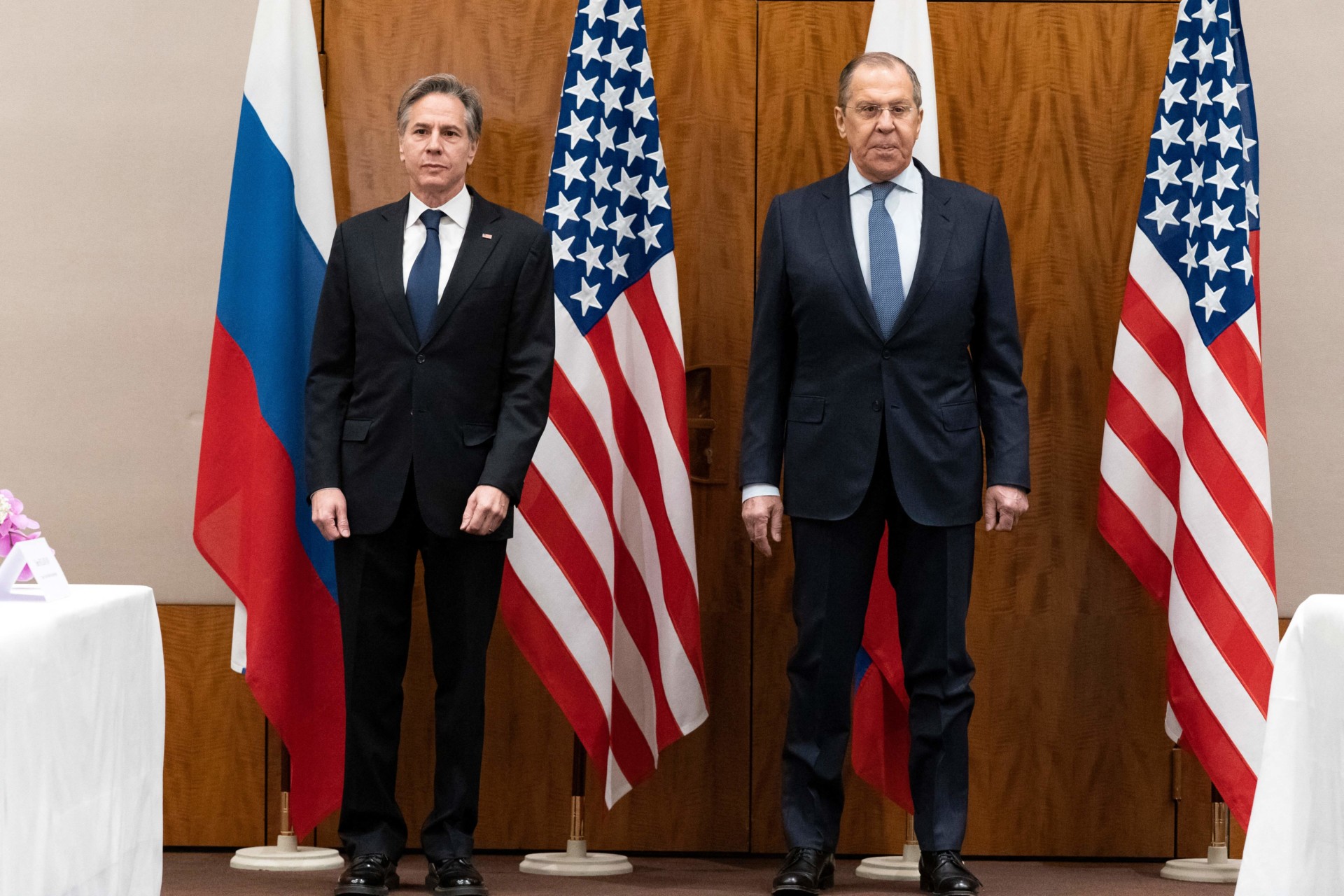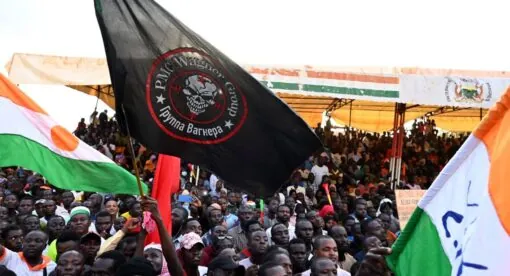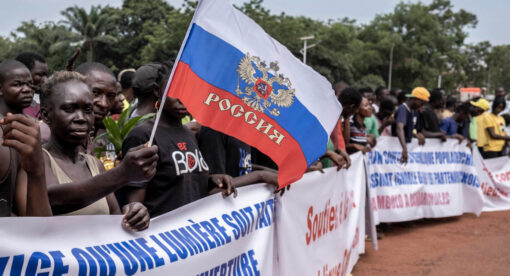The New Lines Institute for Strategy and Policy Open-Source Intelligence Team has developed a scenario analysis exercise for a potential crisis caused by Russia in Ukraine. This exercise engaged experts on Russia, Ukraine, Europe, U.S. policy on Russia and Europe, NATO, geopolitics, and military campaign analysis and was paired with the Institute’s open-source intelligence methodology. We have identified several courses of action Russia might follow in a potential crisis in Ukraine, organized according to two alternate competing hypotheses:
- Russia resumes a conventional military campaign in Ukraine
- Russia refrains from a conventional military campaign in Ukraine and instead focuses on hybrid warfare/gray zone methods
These hypotheses agree that Russia’s overarching goal in a potential crisis in Ukraine would be to destabilize the current Ukrainian government, led by President Volodymyr Zelensky, and neutralize or reverse its pro-Western orientation. They also agree that the most dangerous course of action for Russia to take would be to resume a conventional military campaign against Ukraine, invade Ukrainian territory up to the Dnieper River, and place Kyiv under siege.
A U.S.-Russian Standoff
Following weeks of negotiations between Russia and the West – the latest being a Jan. 21 meeting between U.S. Secretary of State Antony Blinken and Russian Foreign Minister Sergei Lavrov in Geneva – amid military buildups by both Russian and NATO forces in Eastern Europe, the Ukraine crisis appears to be nearing a decision point. Russia has laid out its own security proposals to resolve the standoff, which include NATO abandoning plans to add Ukraine as a member and revert its force posture back to 1997 levels (prior to its expansion to much of Central and Eastern Europe), as well as bans on the deployment of strategic weapons by the U.S. and NATO to this region. Blinken said following his meeting with Lavrov that the U.S. would share in writing a response to Russia’s proposals next week.
Central to the crisis is whether Russia will resume the military campaign it started in Ukraine in 2014. Up to this point, Russia has predominantly worked via its proxies in eastern Ukraine, which has culminated in pro-Russian rump states on Ukrainian territory but has not achieved Moscow’s goal of a pro-Russian change in the Ukrainian government’s behavior. The current military buildup shows Russia’s willingness to resume its campaign to achieve this goal.
Two questions drive the U.S. response to the crisis:
- Can the gains made in NATO membership since 1997 be reversed, and if so, for what purpose?
- What energy, resources, lives, and escalation are the U.S. willing to risk in Ukraine?
The answer to the first question is clear: The Biden administration is highly unlikely to trade away the NATO membership of states that have joined the alliance since 1997. The answer to the second is less certain, but both Russia and the United States have shown a strong aversion to open conflict, as shown in Syria since the countries’ 2015 deconfliction agreement.
Russia has a decisive operational edge in a potential offensive and invasion of Ukrainian territory that would make a NATO counteroffensive highly challenging. However, as is widely reported, the Biden administration is considering the adoption of different rules in Ukraine, preparing to support an open-ended insurgency by Ukrainians against a Russian military occupation. From the U.S. perspective, supporting sovereign Ukrainian forces to wage foreign internal defense, likely by seeding non-U.S. military personnel in Ukraine and through lethal and non-lethal military support from neighboring NATO countries, might seem to be a low-cost, high-reward campaign. But depending on the cost to Russian forces in Ukraine in this scenario, such an approach could lead to Russian escalation against Ukraine’s NATO neighbors through intelligence operations or proxies. This could cause the Ukraine question to become entwined with the question of the future of NATO and force uncomfortable decision points on Washington, Brussels, and powerful states within NATO such as France, Germany, Poland, and the United Kingdom, that have different views of the alliance’s relationship to Russia and the former Soviet space in Eastern Europe.
No matter Russia’s course of action, the U.S. will need to engage in sustained diplomatic engagement with the aim of de-escalation, given Russia’s military buildup and operational advantages. Stalled discussions and a series of demands issued by the Kremlin additionally have forced the U.S. to consider reconciling the posture of NATO tripwire deployments and the positions of offensive missile systems as a means for de-escalation. Moscow’s demands for a U.S. response to its security proposals can be seen either as Russia laying the groundwork for justifying military action in Ukraine or attempting to extract concessions as part of a diplomatic compromise.
Moscow’s Geopolitical Considerations
Russian President Vladimir Putin’s calculus in Ukraine is in large part rooted in Russia’s geopolitical imperatives: domestic political consolidation, protection from neighbors and external powers, and entrenching its influence in former Soviet states. It could be argued that Putin’s goal in Ukraine is not simply the appearance of strength and to invade the country at any cost but rather to consolidate his political and security position at home while preventing NATO encroachment and keeping Ukraine out of the Western orbit. Perhaps counterintuitively, a Russian invasion of Ukraine could violate all three of these imperatives. Also potentially deterring a full-scale Russian invasion are the significant consequences the U.S. and its Western allies have threatened, including crippling sanctions, increased security support for Ukraine (including aiding an anti-Russian insurgency), and further military buildups in NATO front-line states.
However, this does not mean Russia will do nothing. Russia can pursue several hybrid strategies, from cyberattacks to covert actions to military deployments to allied countries like Belarus. If Russia acts, it could be in a manner not limited to Ukraine, and in a way that many don’t expect.
Russia’s current military buildup near Ukraine also has several subtle differences from previous such actions that point toward at least the potential for military conflict, including a flooding of military units to the conflict area, personnel to fill out these units, and specialized and support equipment.
Since November 2021, military forces from across the entirety of Russia have been streaming toward Ukraine and into Belarus. This mirrors, in some ways, previous Russian military build-ups that ended as bluffs; however, the incorporation of units from the Eastern Military District is noteworthy. While Russia has deployed units from this region to Ukraine previously, doing so now shows Moscow’s intent to increase its military presence in the area, either to hold the line or for potential expeditionary aims.
The arrival of specialized and support units, along with the staffing and fleshing out of military encampments in the conflict zone, are more warning signs of potential military action. In recent weeks, videos detailing the arrival of main battle tanks, multiple rocket launch systems, armored personnel carriers, and conventional artillery have been accompanied by videos of logistics and fuel vehicles; repair and recovery vehicles; weather and artillery radar vehicles; and chemical, biological, radiological, and nuclear reconnaissance vehicles. Taken together, they indicate an increase in support and specialized vehicles, something necessary for actual military action.
In a strategic sense, Putin sees right now as a window of opportunity to revisit and renegotiate the West’s strategic position in the entire post-Soviet landscape, not just in Ukraine. Russia currently is displaying its capabilities without yet using them, waiting to see how many concessions it can extract short of war and then re-evaluating its options, knowing the consequences of open war.
Eugene Chausovsky is a Nonresident Fellow with the New Lines Institute. Previously, he served as Senior Eurasia Analyst at Stratfor for 10 years. His work focuses on political, economic, and security issues pertaining to the former Soviet Union, Europe, and Latin America. He tweets at @EugeneChausovsk.
Nicholas A. Heras is the Deputy Director of the Human Security unit at New Lines. Prior to the New Lines, he was the Director of Government Relations and the Middle East Security Program Manager at the Institute for the Study of War (ISW). Nicholas has authored or co-authored numerous reports and analytical articles on topics concerning Global and Middle East security issues, presented widely on these topics to multiple U.S. government and military agencies, and non-government organizations. He has been a frequent commentator to the media on Global and Middle East security issues. He tweets at @NicholasAHeras.
Caroline Rose is a Senior Analyst and Head of the Strategic Vacuums program in the Human Security unit at New Lines. Her commentary and work on geopolitics and Middle Eastern affairs have been featured in Foreign Policy, The Independent, Alhurra, Limes Magazine, and the Atlantic Council’s MENASource. She tweets at @CarolineRose8.
Aram Shabanian is an intern with the Non-State Actors Program in the Human Security unit at New Lines where he focuses on researching and analyzing violent far-right groups in the US, as well as the Islamic State group and associated movements. He focuses on utilizing a mixture of traditional research methods with modern-day, technology-assisted open-source intelligence. He has an MA in Non-Proliferation and Terrorism Studies from the Middlebury Institute of International Studies at Monterey. He tweets at @ShabanianAram
The views expressed in this article are those of the authors and not an official policy or position of the Newlines Institute.










